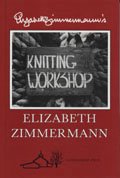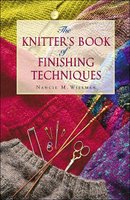Here is how it looks as garter stitch on size 8's:

I have since switched from straights to a short circular, however, as the small gauge required that I cast on a lot of stitches and I'd like to see how the knitting looks when not bunched up.
It is such a wonderfully soft and silky yarn, and although a tiny bit splitty, it makes a lovely fabric. The label that came with the yarn did not give a needle size recommendation, but I'm guessing for a garment one would want to use something smaller, like a 6 or 7, so that it will knit tighter. (I did not try a stockinette stitch gauge swatch, so that's just a guess. The garter stitch is still somewhat open and airy on size 8's.) I don't own any size 6 or 7 needles, however, and also can't bear the though of this taking any longer than it already does to knit. Lots of relatively tiny stitches per row means ones progress only creeps, at best. I don't know how you fancy knitters knit sweaters with small gauge yarns. I think I'd go crazy. But perhaps I'll get faster and better with time and then won't mind tiny gauge so much. (God help me if I start knitting socks anytime soon!)
Anyway, I left the group yesterday with a few unanswered knitting questions, and am hoping someone might be able to enlighten me:
1) One of the reasons why I didn't like this triangular shawl pattern is that I did not like how the increased stitches looked -- they seemed bigger (holey-er) somehow, and to me that looked messy. If I instead increased by knitting a new stitch on to the end of the row, (sorta like a knitted cast-on), or by doing an M1 ("Make One"), would either of those be a less obvious-looking increase?
2) I am an admitted mathophobe, and for the non-math-impaired, this is probably easy to figure out, but I can't wrap my brain around it. Does anyone know a good calculation, (or a good website that will do the calculation) for how to determine how much yarn is needed if:the desired finished object = X inches²,
one's rows/inch gauge = Y, and
stitches/inch gauge = Z?
3) Someone brought in a shawl knitted by a coworker which was just lovely. The entire thing was knitted in seed stitch. However, what was fascinating all of us was how the long edges were knitted. It almost looked like the edges were crocheted, but upon closer inspection, it was obvious that they were just part of the knitting. If you were looking at the knitting item edge-on, it was a perfectly-even knitted stitch all the way up, like this:V
V
V
Vthat is, if the shawl is held vertically. (Not sure this is making sense). Anyway, it was the neatest (as in tidiest) edging I'd ever seen, and I theorized that perhaps it was created by slipping*** the first stitch of every row? I'd read somewhere, (in an E.Z. book, perhaps?), that that was a way to make nice neat edges. I'd really love to know how to do that edging, because once I find out I'll be putting it on all my rectangles from now on!
(***Update: I believe it is, in fact, a slip-stitch edge. Bess confirmed it in the comments, and I also found a good photographic example here.)
And speaking of E.Z., (as in the venerable Elizabeth Zimmerman, of whom many knitters speak of with hushed and reverant tones), I'd recently heard from that enabler Bess that there were a series of wonderful E.Z. videos for purchase. My response was that if they were ever available on DVD, I'd snap them up. Well, sure enough, Schoolhouse Press, run now by E.Z.'s daughter Meg, has them now on DVD, (and for much less than the video versions, and if you buy the book and DVDs together you get a 10% discount), so you probably know where this is going....
Thursday the UPS man brought me these:
And all I have to say about that is -- Yippee!
And since we're discussing additions to the knitting library, I have one more to mention. I'm really trying to be good and not buy every knitting book I see, as many contain duplicate content, many have questionable quality, and frankly, I don't have the room for more books in my house. When I get obsessive about a hobby I start accumulating books around that subject area, and I'm really trying to be better about that. I have several entire bookcases full of gardening books. I'd like to keep the knitting library down to one shelf, if possible.
But I made an exception for one more knitting book. While at Books-a-Million the other day looking for a sports almanac for my teenage nephew's birthday, I of course had to browse through the knitting book section. Fortunately there weren't too many enticements except a dog-eared copy of Vogue Knitting Quick Reference which I resisted because it was fairly beat up -- if/when I get that, I want it to be brand-spankin' new so that I alone can dog-ear it! I almost got out of that store scott-free until I saw:
As mentioned previously, Ms. Wiseman is coming to town next weekend and I'll be taking a class from her on Sunday. So many folks have said her book is fantastic, I figured I'd probably end up with it sooner or later. And now I'll have it for her to sign next week.
Whoo!, and might I add, Hoo!
***



5 comments:
In answer to the question about the edging - yes - that's how it's done - by slipping the first (or last) stitch of each row.
As for the increases - there are many different increases. My favorite is to knit a stitch into the stitch of the row below - which may not make sense, but which I will be glad to show you when we get together - if Nancie Wiseman doesn't show you at your workshop.
I am sooooooo envious of that! I try to take the classes by venerable teachers who come to Richmond but I'm out of town next weekend.
As for the calculator thing - well....
I have heard that a stitch uses up aproximately 1.5 inches of yarn. Plug that in and see what you get.
No Math here either.
Can't wait to hear about your class next week. Good idea to have the book.
Just wanted to also say "Thanks for stopping by my blog and YES! I would love to see a picture of the ice cream boat at Lake Gaston"
I'll do my best at answering your questions :-)
1. I just wanted to add to Bess's answer that the increase she mentions is shown in The art of knitting DVD. The Henrico library has a copy but I don't know about your library. Maybe you can get it via inter-library loan?
2. There is a good article telling you what you need to do here (scroll down to A more accurate method)or there are many knitting programs that will do it for you :-)
HTH
I love the colorway on the Blue Heron. Refreshing for spring...can't wait to see your progress!
Very nice blog.
Did you visit my blog???
Post a Comment